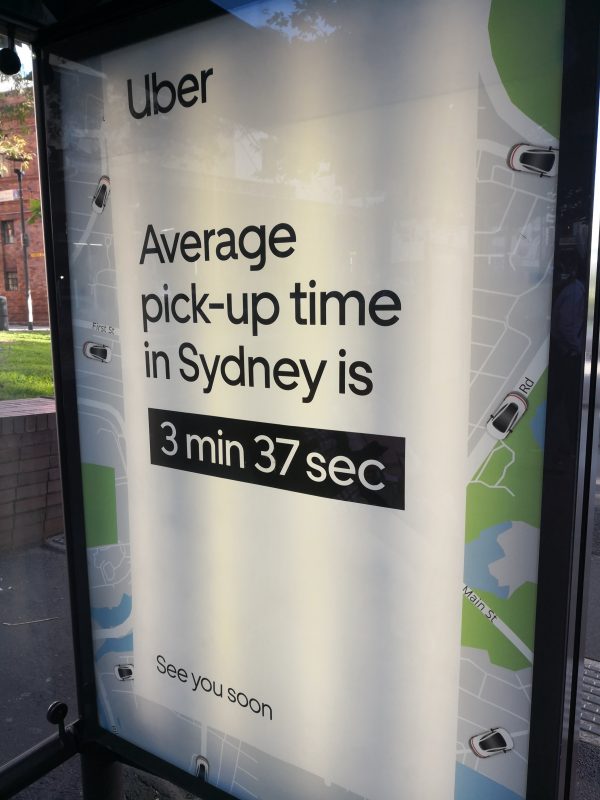The data is there for advertisers, we just need to learn how to use it
The future of advertising is predictive, argues Regan Kerr. And to start, brands need to focus less on the ‘who’ and ‘what’, and more on the ‘where’ and ‘when’.
I saw this ad for Uber at a bus stop in Redfern on my walk home recently, and it struck me as an unusual piece of advertising.

From a creative perspective, it seems to be missing a big idea. This data – the average pick-up time in Sydney – would normally be presented as the insight, or reason to believe.
But this is Uber’s entire premise. Push a button, wait three minutes and thirty-eight seconds, and, on average, there’ll be a ride waiting for you. Potentially, it’s the most on-brand ad Uber has ever run.


A really valuable read. Thank you
So, basically as it has always been.
But glad you ‘get it’.
+1
Thanks Regan. Several interesting/valid use-cases brought to life with some nice examples in this piece. To become truly predictive, even with all the machine learning in the world, there’s still work to do on the measurement front I’d say.
Thanks Regan, great perspective
A great example of de-mystifying data. The more Mutiny presents its case, the more I’m convinced of their offering. Nice read Regan.
This type of tactical contextual messaging will become less effective when there is a competitive brand that offers the same service. If you don’t build a higher purpose (reason to be – not CSR) that you can’t build memory structures around the brand and people won’t chose that service. They’ll be reminded of the need but will chose something they have a bond with in the category. Contextual messaging without brand building isn’t going to work long term.
Maccas have had arrows and signs to their closest store as outdoor advertising for decades. It’s brilliant and contextually relevant. But they couldn’t have built a brand a brand of the size and stature on this alone. Media agencies push this type of work as it makes their process and solutions seem more valuable (see digital performence marketing also) but you can’t build a brand in this way.
This type of ROI mentioned is dangerous. It doesn’t account for the memory structures about a brand already formed from a number of sources. It creates lazy marketeers who swap long term brand building for fast (seemingly effective) ROI.
Assuming you have both Uber and Lyft apps, and assuming parity between these brands, which service do you think would be first to thumb when you see an Uber message at this moment of need? I don’t think this piece precludes your broader brand-building position. In fact, you’ll find retention in memory is quite strong when the moment of encoding is particularly salient.
The one that has created the most salience for you. If I knew Lyft stood for something I also did, or that Lyft was a brand that felt like the brand I should chose then it could be Lyft and not Uber despite being close to point of purchases. You’re also assuming people are making these choices in a very rational manner and they’re not. Yes being close to point of purchase is half the job. But it’s nothing without salient brand building. My concern, which perhaps I didn’t voice very well, is that as the Uber context example is slightly easier to measure and supposedly attribute to usage – marketeers often favour this sort of work over harder brand building salient work – and often at the expense of it. This is being driven by some media agencies measuring the wrong things and calling it attribution.
My point on the choice of Uber is actually based on a heuristic assumption, whereby the pressure of needing to get to work would dominate the available cognitive load, and the proximal brand prompt might not even register at a rational level when you’re pulling out your phone to call in a ride (sorry to sound wanky on that). I’d say under those conditions it’s more an emotional decision.
I do agree that defining an attribution model accounting for every component of brand building is a next-to-impossible task. I’m not sure purpose is a necessary condition. Done well, its a desirable attribute but I can see multiple successful brands out there without it (e.g. four big banks).
I’ve read Sharp’s book, and it generally makes sense to me but I’m a creative. What it (wisely) steers clear of is being prescriptive with what the creative should actually be, beyond general rules such as distinctiveness vs. differentiation. And it’s on distinctiveness that I think there’s a place for the type of deployment Regan discusses above.
What I liked about this piece is that it simplified how data can be relevant. For some people it’s a derfred, but for others a way through the data overload.
I think we’re agreeing in a roundabout way.
What I’d like to see is more creative contextual work – rather than just an acknowledgement of the context the person is in .
The Spotify campaign for certain locations touched at this but I’ve not seen it improved upon.
I’m often left thinking just because you can do this doesn’t mean you should.
Back to the Uber example. It’s nothing new. People have been using outdoor advertising in this way for decades – for me it lacks an idea or a a higher purpose.
Yep, that Spotify stuff is a great best-of-both-worlds example. Nice chat. Cheers
There is a difference between being in the market to buy a camera and getting people to think ‘hey, I should get more into photography’.
We need ways to do both.
There is no one way of the future I’m afraid.
Long and Short of It proves sales activity (compared to brand activity) is most effective when its rational (compared to emotional).